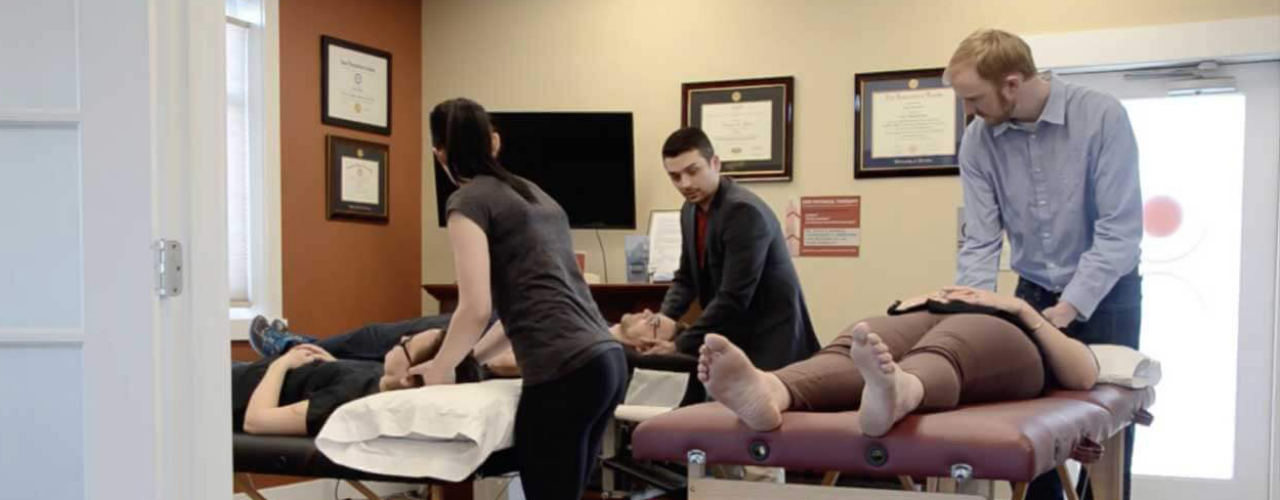This two-day course is comprised of 80% practical and 20% didactic training. The primary focus will be on the development of the psychomotor skills needed to safely and effectively deliver advanced high-velocity, low-amplitude thrust (HVLAT) manipulation to the spinal column, more commonly known as spinal manipulation. Also included will be an in-depth review of mechanisms of benefit and the efficacy/safety of treating select neuromusculoskeletal conditions.
HVLAT: Spine does not have to be taken prior to this course. However, the participant must review the textbook for HVLAT: Spine prior to attending this course.
All IMMT HVLAT courses have been approved for 15 contact hours by PT state boards where the courses are held, as well as the Board of Certification (BOC) for athletic trainers.
Course Objectives
At the completion of this course, the participants will be able to:
- List two biomechanical, endocrine, neuronal, and hormonal findings relative to HVLAT that have been demonstrated in the peer-reviewed literature.
- Discuss how the above findings relative to spinal manipulation may contribute to its effects in neuromusculoskeletal conditions.
- Identify two physiological and accessory levers used in HVLAT techniques for all 4 regions (cervical, thoracic, lumbar, sacrococcygeal) of the vertebral column.
- Perform, given a patient case scenario, evidence-based examination techniques to confirm/refute the appropriateness of HVLAT for vertebral conditions.
- Perform, given a patient case scenario, advanced HVLAT procedures to the vertebral column that produce multiple, localized cavitations.
- Discuss the efficacy of spinal manipulation in the treatment of cervical radiculopathy using two peer-reviewed sources.
- Discuss the efficacy of spinal manipulation in the treatment of lumbar radiculopathy using two peer-reviewed sources.
- Discuss the safety of performing spinal manipulation for cervical or lumbar radiculopathy using two peer-reviewed sources.
- Discuss the efficacy of spinal manipulation in the treatment of rib dysfunction and costochondritis using two peer-reviewed sources.
- Discuss the efficacy of spinal manipulation in the treatment of sacroiliac dysfunction using two peer-reviewed sources.
This course has been approved for 15 contact hours by all state boards where courses are held.
Course Schedule
HVLAT: Spine - Advanced | Day 1 (8 hours)
7:45 am Sign-in
8:00 am Mechanisms of Effect for HVLAT – Part 1
8:45 am Review of HVLAT Part 1 Didactic Material and Techniques
10:00 am Break
10:15 am Sidelying Lumbosacral (T12-S1) Endomorph and Pregnancy/Hypomobility Modifications
11:00 am Seated CTJ (C7-T2) Distraction HVLAT
11:30 am Sacrococcygeal Sidelying HVLAT
12:00 pm Lunch
1:00 pm Mechanisms of Effect for HVLAT – Part 2
2:00 pm Cervical Occipito-Atlantal (C0-C1) Sidebending and Distraction HVLAT
2:45 pm Supine Upper Rib (1-3) AP Cephalad HVLAT
3:15 pm Break
3:30 pm Prone SIJ PA and SIJ PA with Hip Extension HVLAT
4:15 pm First Rib Depression HVLAT
5:00 pm Conclusion of Day 1
HVLAT: Spine - Advanced | Day 2 (8 hours)
7:45 am Sign-in
8:00 am Safety and Efficacy of HVLAT in the Treatment of Radiculopathy, HVLAT in the Treatment of Rib Dysfunction and Costochondritis
8:45 am Prone Sacral TJMs (4 Techniques)
9:30 am Supine Thoracolumbar Junction (T11-L3) Squat-Drop HVLAT
10:15 am Break
10:30 am Seated Cervical to Cervicothoracic (C3-T2) Rotatory HVLAT
11:15 am Reverse Erhard and Lumbar Roll Push-Pull HVLAT
12:00 pm Lunch
1:00 pm HVLAT in the Treatment of Sacroiliac Dysfunction
1:30 pm Supine SIJ Anterior and Prone SIJ Posterior Gapping HVLAT
2:15 pm Seated Cervical (C1-T1) “Downslope” HVLAT, Supine Cervical (C3-T1) Gapping HVLAT
3:00 pm Break
3:15 pm Seated Lower Rib (8-12) PA Cephalad HVLAT
4:00 pm Sidelying Lumbosacral Facet and Top-Hand Modifications (T12-S1) HVLAT, Sidelying Lumbosacral (T12-S1) Hypomobility “Kickstart” HVLAT
5:00 pm Issue Course Certificates, Conclusion of Day 2



